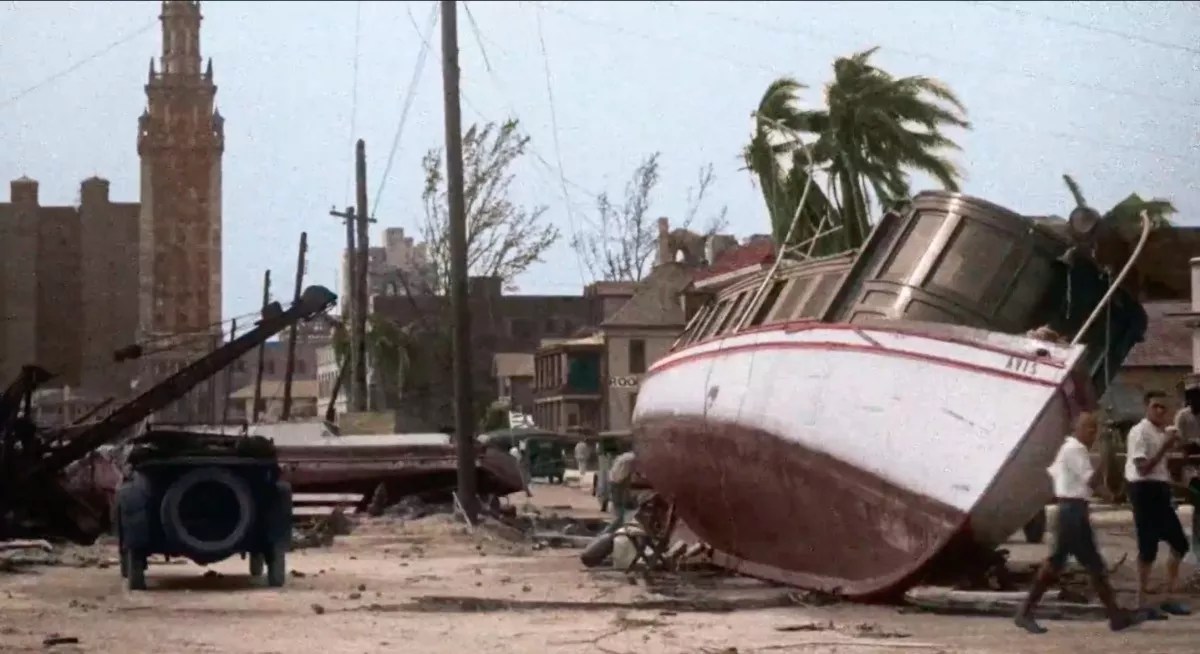
Screenshot via Smithsonian Channel

Audio By Carbonatix
Tipped on its keel against a palm tree, a yacht steeps in a swamp of sand, debris, and stormwater. Surrounding it is a graveyard of Model Ts, their axles bent and canopies shredded. Known as the “Big Blow,” the Great Miami Hurricane of 1926 thrashed across South Florida’s sun-kissed landscape.
For the next 90 years, people across the United States have relived its devastation by watching clips in grainy black-and-white. But now the Smithsonian Channel has premiered a series showing original footage of the devastating storm, this time restored in full color.
The Miami footage aired this weekend as part of the series America in Color, offering five episodes of colorized historical footage spanning five decades of American history from the 1920s to the 1960s. Art director Samuel François-Steininger of Composite Films says the series involved around 3,500 shots and 300,000 frames, requiring a team of 20 more than a year to finalize. For the Miami hurricane footage, colorists worked for weeks on 50 shots and 5,000 frames for a final product of 200 seconds.
“We chose [the hurricane] for the 1920s as it was a strong human story about a natural disaster’s impact upon a thriving ’20s community,” series producer Lucie Ridout writes in an email. “We also felt it might be relatable for a modern audience that still lives in the path of major storms.”
In the 1920s, thousands of Americans migrated to Florida, the so-called party destination for the wealthy, and by 1923 the population of Miami had doubled during an unprecedented real-estate boom. Little did they know that in only three years, a catastrophic storm would lay waste to the city.
During the early hours of September 18, 1926, a 60-mile-wide Category 4 hurricane made landfall near Miami Beach. The state was almost totally unprepared, and evacuation warnings were issued far too late. With winds in excess of 150 mph and storm-surge heights measured at 11 feet above mean high tide, the hurricane scratched a path from South Beach to Tampa Bay, killing 372 people and leaving 43,000 homeless. The storm caused $109 million in damages at the time, which today would amount to $165 billion, making it the costliest storm on record in U.S. history.
Without footage from newsreel cameraman Ralph Radnor Earle of American Pathé News, the rest of the nation might never have really understood the scope of the tragedy in Miami. While trapped for six hours during the storm, Earle captured video clips and still images — a collection commended as being the earliest known storm-chasing footage. After surviving the hurricane, he personally flew the reels north so they could be distributed to 20,000 movie theaters across the nation. Eventually, his work was filed at the Sherman Grinberg Film Library, the world’s oldest and largest privately held film archive.
After the footage was procured from the film library, François-Steininger’s team began to colorize it. He describes the work as a painstaking process because the black-and-white footage was extensively damaged and required heavy restoration, such as manipulating certain information in the greyscale values.
“To find the exact matching colors and achieve a realistic look, we had to analyze every element of every black-and-white shot, such as the environment, sky, cars, buildings and homes, clothes and fashion, et cetera,” he writes in an email.
Because so much of the colorization process relied on historical research, his team collaborated with museums, universities, storm specialists, collectors, and reenactors.
“It was like a police investigation,” he says. “We sometimes needed to cross two or three different sources to find a 100 percent match.”
Smithsonian says its goal for the series, whose next episode will air this Sunday at 8:00 p.m. on the Smithsonian Channel, is to connect modern viewers to earlier American history. As Charles Poe, the series’ executive producer, says to Smithsonian.com: “It’s been really hard until now for people to understand that this really wasn’t ancient history. These were real moments, and they were lived in color.”